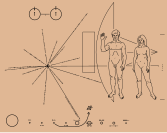Communication is commonly defined as the transmission of information. Its precise definition is disputed and there are disagreements about whether unintentional or failed transmissions are included and whether communication not only transmits meaning but also creates it. Models of communication are simplified overviews of its main components and their interactions. Many models include the idea that a source uses a coding system to express information in the form of a message. The message is sent through a channel to a receiver who has to decode it to understand it. The main field of inquiry investigating communication is called communication studies.
A common way to classify communication is by whether information is exchanged between humans, members of other species, or non-living entities such as computers. For human communication, a central contrast is between verbal and non-verbal communication. Verbal communication involves the exchange of messages in linguistic form, including spoken and written messages as well as sign language. Non-verbal communication happens without the use of a linguistic system, for example, using body language, touch, and facial expressions. Another distinction is between interpersonal communication, which happens between distinct persons, and intrapersonal communication, which is communication with oneself. Communicative competence is the ability to communicate well and applies to the skills of formulating messages and understanding them.
Non-human forms of communication include animal and plant communication. Researchers in this field often refine their definition of communicative behavior by including the criteria that observable responses are present and that the participants benefit from the exchange. Animal communication is used in areas like courtship and mating, parent–offspring relations, navigation, and self-defense. Communication through chemicals is particularly important for the relatively immobile plants. For example, maple trees release so-called volatile organic compounds into the air to warn other plants of a herbivore attack. Most communication takes place between members of the same species. The reason is that its purpose is usually some form of cooperation, which is not as common between different species. Interspecies communication happens mainly in cases of symbiotic relationships. For instance, many flowers use symmetrical shapes and distinctive colors to signal to insects where nectar is located. Humans engage in interspecies communication when interacting with pets and working animals.
Human communication has a long history and how people exchange information has changed over time. These changes were usually triggered by the development of new communication technologies. Examples are the invention of writing systems, the development of mass printing, the use of radio and television, and the invention of the internet. The technological advances also led to new forms of communication, such as the exchange of data between computers.





